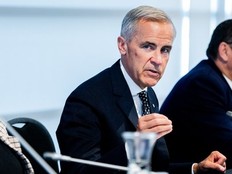GOLDSTEIN: Carney’s hocus-pocus plan to increase debt and balance the budget

Article content
Prime Minister Mark Carney’s promise that his government will “spend less and invest more” is the same sort of fiscal flimflammery as Justin Trudeau’s claim in 2014 that as prime minister he would grow the economy and “the budget will balance itself.”
The budget never balanced itself under Trudeau, even before the pandemic hit in 2020.
His 2015 election pledge of three years of “modest deficits” in 2016, 2017 and 2018 followed by a balanced budget in 2019, turned out to be a myth.
As for Carney’s pledge to “spend less and invest more” respected University of Calgary economist Trevor Tombe, writing in The Hub, noted that “Conservative Leader Pierre Poilievre dismissed Carney’s proposal as ‘cooking the books’ and history justifies the skepticism.”
Carney dismissed that criticism by suggesting he has more experience than Tombe as an economist and economic manager.
Jake Fuss, director of fiscal studies for the Fraser Institute, called Carney’s pledge “creative accounting” because “Mr. Carney’s math doesn’t add up.”
In fact, Carney is planning to spend more and borrow more than the Trudeau government.
This while abandoning the “fiscal guardrails” that former federal finance minister Chrystia Freeland said were important to maintain the integrity of federal finances, at least prior to her resigning when she said the Trudeau government had abandoned them.
Freeland is now minister of transport and internal trade in Carney’s cabinet, so perhaps she’s changed her mind.
So how is Carney going to make good on his promise to balance the budget in three years while spending more and increasing the debt?
This apparent economic miracle will only be achievable because Carney is making a new distinction in government spending.
He’s separating the operating expenses of the federal government — the cost of daily operations, plus cash transfers to the provinces and benefit programs such as Old Age Security, $10-a-day daycare and dental care — from capital spending on infrastructure.
Carney, who criticized Trudeau for driving up the operating costs of the government by an average of 9% annually, says he will reduce those increases to less than 2%.
He will then invest more money, financed by more public debt, in fast-tracked, nation-building infrastructure projects such as housing construction, making Canada a clean energy superpower and other initiatives designed to bolster our economy and make it less reliant on the U.S.
The problem with redefining debt is that it’s still debt for the people who have to pay it back with interest — taxpayers.
As Tombe, put it, “Carney’s financial sleight of hand will not actually balance the budget.”
Carney’s election campaign platform outlined $130 billion in new spending over four years with total deficit spending of $224.8 billion.
That’s 71% higher than the $131.4 billion in deficit spending the Trudeau government predicted during the same period in its fall economic statement last December, although had Trudeau decided to run again his election promises would have increased his projected deficits.
To be sure, if will be a positive step if Carney can significantly reduce the operating costs of the government, a major component of which is the cost of the federal public service.
But it will also be interesting to see how he will achieve this, given that his intention, aside from making use of Artificial Intelligence, is to cap the size of the public service at its current level of approximately 357,965 people.
That’s an increase of more than 100,000 civil servants — almost 40% — compared to when Trudeau took office in 2015.
Carney’s promises also depend, according to his campaign platform, on achieving $28 billion in savings from “increased government productivity”, $3.75 billion from “increasing fines and penalties” and $20 billion from revenue generated by Canada’s counter-tariffs in its trade war with U.S. President Donald Trump.
Some economists agree with Carney that redefining public debt into operating and capital spending components will make it more transparent, but others warn the temptation will be to redefine operational expenses as capital investments, in order to meet Carney’s promise of a balanced operating budget in three years.
What the Carney government intends to classify as operational expenses versus capital investments won’t be known until the Liberals unveil their budget in the fall.
That said, capital spending to fund infrastructure in tough economic times to boost the economy is hardly a new concept.
Done competently, it can work as planned, in the same way a homeowner taking out a mortgage to buy a home can increase the family’s equity, provided he or she can meet the mortgage payments.
The key word is competently.
One of many examples of previous capital investments by governments in concert with the private sector turning into financial disasters are Light Rail Transit projects in cities such as Toronto and Ottawa, funded by the federal, provincial and municipal governments.
Meanwhile, parliamentary budget officer Yves Giroux reported last year that the federal, Ontario and Quebec governments have earmarked up to $52.5 billion — 60% paid by the feds, 40% by the provinces — for 13 projects intended to create an electric vehicle and EV battery industry in Canada.
That’s $6.3 billion or 14% more than the $46.1 billion the industry plans to invest in these projects, with many companies now cutting back or delaying production due to slow EV sales.













Postmedia is committed to maintaining a lively but civil forum for discussion. Please keep comments relevant and respectful. Comments may take up to an hour to appear on the site. You will receive an email if there is a reply to your comment, an update to a thread you follow or if a user you follow comments. Visit our Community Guidelines for more information.